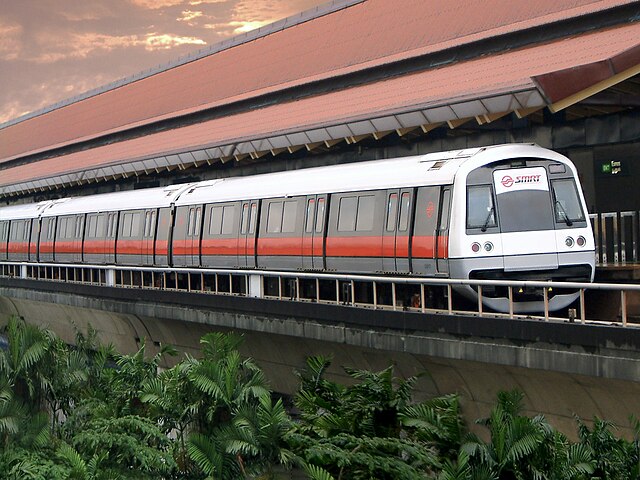Top Qs
Timeline
Chat
Perspective
Nippon Sharyo
Japanese rolling stock manufacturer From Wikipedia, the free encyclopedia
Remove ads
Nippon Sharyo, Ltd. (日本車輌製造株式会社, Nippon Sharyō Seizō kabushiki gaisha; literally "Japan Rolling Stock Manufacture Company" and formerly known outside Japan as Nippon Sharyo Seizo Kaisha, Ltd.), formed in 1896, is a major rolling stock, heavy equipment, generator, special purpose vehicle and bridge manufacturer based in Nagoya, Japan. In 1996, it abbreviated its name to "日本車両" Nippon Sharyō. Its shortest abbreviation is Nissha "日車". It was a listed company on Nikkei 225 until 2004. It is listed on the Tokyo Stock Exchange and Nagoya Stock Exchange as ticker 7102. In 2008, Central Japan Railway Company (JR Central) became the majority shareholder (50.1%) of the financially struggling Nippon Sharyo making the firm a "consolidated subsidiary" of JR Central. In July 2012 Nippon Sharyo USA started production in their new facility in Rochelle, Illinois. The facility closed at the end of October 2018 due to a lack of orders.[1][2]
This article possibly contains original research. (April 2023) |














Remove ads
Notable projects
Summarize
Perspective
Rolling Stock
 Japan
Japan
- Shinkansen ("bullet train") trainsets
- Odakyu Electric Railway trainsets
- Linimo maglev train
- Keisei Electric Railway trainsets
- Nearly all Meitetsu trains
 Argentina
Argentina
 Brazil
Brazil
- SuperVIA Série 500
- Porto Alegre Metro EMUs
 Canada
Canada
- Toronto Transit Commission work cars
- RT10 Garbage car 1967 – Tokyo Rose retired in 2000 and scrapped
- RT12 Electric locomotive 1968 (design similar to JNR Class DE locomotive), retired 2009 and scrapped
- RT13 Centre cab crane 1968 – with car and crane cabs
- RT22 Flat car 1973 – formerly wash car RT-17 and rebuilt 1996
- RT54 flat car 1973
- Union Pearson Express Diesel Multiple Units
- Nippon Sharyo DMU (jointly with Sumitomo Corporation) 2014
 Philippines
Philippines
- Manila Light Rail Transit System Line 1 (jointly with Kinki Sharyo)
 Singapore
Singapore
 Republic of China
Republic of China
 United States
United States
- Next Generation Bi-Level Passenger Rail Car
- Los Angeles County Metro Rail P865 and P2020
- Northern Indiana South Shore Line EMUs
- Maryland MARC Train single-level push-pull coaches (jointly with Sumitomo Corporation)
- Bi-level gallery cars[7] for Chicago Metra, Virginia VRE, and San Francisco Bay Area Caltrain
- Highliner bi-level EMUs for Metra and South Shore Line
- Sonoma–Marin Area Rail Transit Nippon Sharyo DMU (jointly with Sumitomo Corporation)[7]
 Venezuela
Venezuela
I.F.E EMUs Working on Caracas-Cua commuter line Railway System Ezequiel Zamora (Central)
 Indonesia
Indonesia
Rheostatic series (KRL Rheostatik Mild Steel and Stainless) (The train was also made by Kawasaki Heavy Industries and Hitachi):
- Built 1976: Has 2 doors and uses mild steel body types
- Built 1978,1983,1984: Has 3 doors and uses mild steel body types
- Built 1986,1987: Has 3 doors and uses stainless steel body types
All Rheostatic EMUs have stopped operating in the Jabodetabek lines and is currently waiting to be scrapped.
Shinko Diesel Multiple Units (a.k.a. KRD MCW 301 and KRD MCW 302[circular reference]) are used for short-distance lines such as Surabaya-Lamongan, Surabaya-Sidoarjo, etc.
- KRD MCW 301 Built 1976: Has 2 doors and uses mild steel body types
- KRD MCW 302 Built 1978,1980,1982,1987: Has 3 doors and uses mild steel body types
KRD MCW 301 and 302 initially uses the Shinko DMH17H engine and Niigata TCR 2.5 transmission
Note: The DMUs built in 1976 are now used as regular loco-hauled trains without engines. The DMUs made in 1978, 1980, & 1982 upwards are refurbished with a Cummins Engine (NT885-R) and Voith turbo (T211re.3) transmission.
The new rolling stock, known as the MRTJ 1000, was built specifically for the Jakarta MRT[8]
 Thailand
Thailand
- State Railway of Thailand
- SL
- C56 (Numbers 715-716 and 723-729 or formerly owned by Japanese Government Railways, numbers 17-18 ,28 ,30-32 ,34 and 36-37 In 1979, Japan asked to buy back the steam locomotive C56, number 725, original C56 31, back to its homeland of Japan. It is on display at the Yūshūkan Museum. But there are traces of having been used in Thailand. The driver's cab has the number 725 and the transport vehicle has Thai letters (ร.ฟ.ท.) SRT.)
- DX50 (Numbers 351-352 and 363-364)
- CX50 (Numbers 288-292 ,821-834 ,837-841 and 850)
- DMU
- SL
 Jordan
Jordan
Five Pacific locomotives were built by Nippon Sharyo for the State Railway of Thailand in 1953 to the same design of Pacific locomotives introduced in 1942 and 1949 for the railway, but were never delivered. Later, they would be allocated to the Jordan Hejaz Railway (JHR) after a conversion to 1050mm gauge and renumbering to nos. 81-5.[9]
- CX50 (Numbers 81-85)
Remove ads
Other Products


- Unit load device
- Buffer stop
- Earth Drill Machine
Diesel Generators
- Diesel generator
- Portable Generators
- Electric Welding Machine
Transport Equipment
Bridges
Remove ads
Wartime involvement

Nippon Sharyo, in 1936, built the JNR Class C56 steam locomotive number C56 31, which was used in 1943 to open the infamous Thai-Burma Railway, as stylized in the movie The Bridge Over the River Kwai, built by over 100,000 Allied POW and other slave labourers. This restored steam engine now sits in the foyer of the Yasukuni War Museum in Tokyo. Japanese veteran groups raised funds to return the locomotive from Thailand to Japan in 1979.
During World War II, Nippon Sharyo, like many major Japanese companies, drew upon prisoner of war labour to maintain war production. The POW camp at Narumi provided Allied POW forced labour for Nippon Sharyo.[10]
References
External links
Wikiwand - on
Seamless Wikipedia browsing. On steroids.
Remove ads

